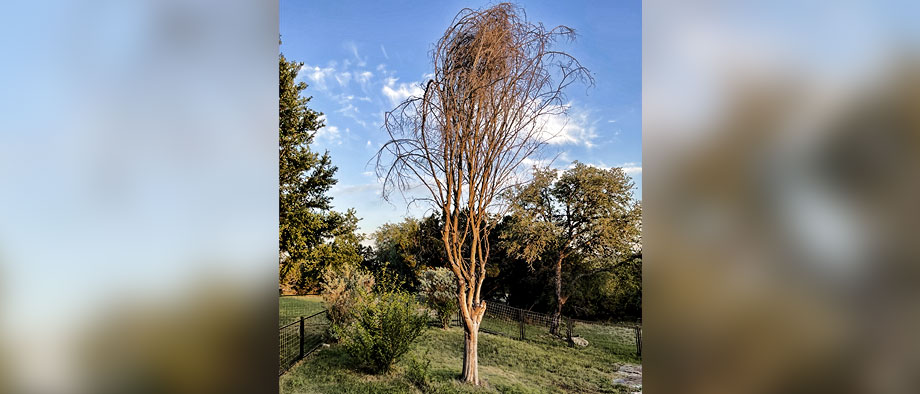There’s more to the Texas drought than water shortages and wildfires.
Trees are withering, too. In 2011 drought killed an estimated 300 million trees, 5.6 million of them being urban shade trees
Texas A&M Forest Services says trees are taking a hit again.
Drought alone may not kill trees, but it could be the “tipping domino” of tree mortality.
Stressors
Lack of rain causes significant stress, which reduces the capacity of trees to function efficiently and grow vigorously.
“Stresses are things that can affect growth, nutrient uptake, the ability of the tree to photosynthesize and ultimately the ability of the tree to defend itself against pathogens, things like heat, cold, predation from animals, insects and diseases — a number of things,” said Karl Flocke, a Texas A&M Forest Service woodland ecologist.
Without water, a tree cannot generate sugars or use them — a necessary part of tree growth.
Secondary pests and diseases are those that attack a tree that is already stressed by something else, such as a drought or a winter storm.
Problems can continue for years after a drought or other large stressor event has ended. It takes time for trees to recover. the forest service said.
“Plants generate their own food though photosynthesis and one of the key components of photosynthesis is water,” Flocke said. “Water is necessary for the chemical reactions that create sugars, it’s also necessary to help move the needed materials around in the tree and finally, to utilize those materials.”
When this happens, trees will start to show physical symptoms of the lack of nutrients. While these symptoms can vary from species to species, most trees will begin to show signs of water stress through their leaves.
Watering
Flocke said the most helpful way to reduce stress during a drought is to give trees supplemental water.
“Watering is going to depend on the tree; the size, species and age of the tree as well as the soils you have in your area,” Flocke said. “If you have established trees that are well-adapted to your location, it’s very likely that they might not need supplemental water at all. But I would monitor them to look for signs of stress.”
If you begin to see signs of stress in your trees and the ground under your trees is extremely dry, it’s time to begin watering, he said.
To test the dryness of the soil, take a long screwdriver and stick it in the ground. If the screwdriver doesn’t go easily six to eight inches into the soil, it’s time to water.
“Start by watering the area around the canopy of the tree,” Flocke said. “Not just at the base of the tree and not just around the edge of the dripline but water the entire area underneath the canopy of the tree until the point where you have water start pooling and running off the surface.”
Watering can be done with a water hose, soaker hose, sprinkler or bucket – each way being efficient so long as the tree is getting the water it needs. A good guideline for the amount of water your tree needs is two to three gallons per one inch trunk diameter.
Newly planted trees should be watered up to three times per week during a drought, he said.
Larger trees may not need much watering but extremely high temperatures and lack of precipitation warrants watering every couple of weeks.
However, residents should adhere to water restrictions.
“The most important thing is to avoid watering during the heat of the day because much more water is going to be lost in evaporation,” Flocke said. “Either early in the morning or later in the evening is the best time to water.”
Mulching
Mulching is another way to help trees manage drought stress.
It’s easy and inexpensive and conserves water, regulates soil temperatures, reduces competition from other plants and improves soil health.
“In general, apply a layer of mulch no more than two to three inches deep,” said Flocke. “In reality, the entire area under the canopy could be mulched, but mulching out several feet around the base of the tree, being sure not to let the mulch touch the base of the trunk, will help.”
Pruning
Another tip is to avoid pruning, which stresses trees further.
“What you’re trying to do is reduce stress to the tree, so pruning, even when you have to, is adding stress because you are wounding the tree,” said Courtney Blevins, Texas A&M Forest Servce urban forester.
“If you’re pruning out live branches or live leaf areas of the tree, you’re removing food and the site where the tree’s root growth hormone is developed, affecting root growth and further stressing the tree at a time where it’s already too stressed,” she said.
According to Blevins, the exception to pruning trees during drought is a completely dead branch or one that is a hazard to its surroundings.
Fertilizer
Putting down fertilizer is another no-no.
“Just generally applying fertilizers without knowing if there is a deficiency is a really bad idea,” she said. “If there is not a nutrient deficiency then it’s not going to help anything, and it can actually hurt things and make the tree worse.”




